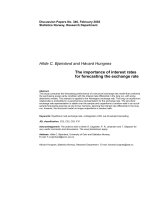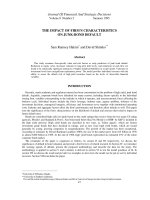Tài liệu Social Impact Bonds - Rethinking finance for social outcomes pdf
Bạn đang xem bản rút gọn của tài liệu. Xem và tải ngay bản đầy đủ của tài liệu tại đây (365.07 KB, 8 trang )
1
Social Impact Bonds
Social Impact Bonds
Rethinking finance for social outcomes
August 2009
Social Impact Bonds
2
In the UK, 40,200
1
adults leave prison each year after
serving a custodial sentence of less than 12 months.
These prison places cost the tax-payer well over
£213 million a year
2
yet, on release, adults on short
sentences receive no formal support to help them
to successfully resettle into the community. 73%
3
of
these offenders go on to reoffend within 2 years of
release (92%
4
for those under the age of 21 years).
Government spending on a range of deep-rooted
social issues, including healthcare, adult mental
health, and school truancy and exclusion, is similarly
focussed on expensive interventions that deal with
the consequences of the issue rather than addressing
the root causes:
P Of £92 billion health expenditure in England, only
3.7% is spent on preventative interventions;
5
P Adult mental health costs government £10bn each
year in benefi t payments alone, while only £2m is
spent on mental health promotion activities like
promoting self-esteem and coping skills;
6
P Government spends £650m on truancy and £800m
7
per annum on school exclusions while only £111m
8
is spent on preventative initiatives.
Government budgets are limited and early
intervention spending is easier to cut in diffi cult times.
Over time this creates a self-perpetuating pattern
of expenditure, resulting in ever worsening social
outcomes and an ever growing need for government
resources to be spent on expensive crisis interventions
(Figure 1).
Figure 1. Catch 22: Negative spending cycle caused by low levels of early intervention expenditure
Social Impact Bonds
Higher level of
spending on crisis
inter
vention
s
Fewer resources
available
for early
inter
vention
s
Poorer social
outcomes, more
individuals
requiring crisis
inter
ventions
Historically, charitable trusts and foundations have
sought to prevent acute social problems in the UK,
using grants to demonstrate and fund interventions
that improve social outcomes and reduce the number
of individuals requiring crisis interventions. Trust and
foundation resources are limited however – only
£4.4bn
9
per year compared to government budgets
of £603bn
10
– enabling them to demonstrate effective
interventions, but not to make them available to
everyone who would benefi t. Without reliable, large-
scale funding for prevention and early intervention,
trusts and foundations are left to fund effective
interventions, on a relatively small scale, indefi nitely.
In response to this situation, Social Finance has
developed a new contracting and fi nancing
mechanism: the Social Impact Bond. Social Impact
Bonds seek to drive signifi cant non-government
investment into addressing the causes of deep-
rooted social problems with returns generated from
a proportion of the related reduction in spending
on acute services. The ambition is to create positive
government spending cycles that enable signifi cant
tax payer savings through improved social outcomes
(Figure 2).
We believe that Social Impact Bonds have the
potential to transform the way that a wide range
of social outcomes are achieved (Appendix 1). We
have been working with a number of government
departments to develop a pilot.
3
Social Impact Bonds
Social Impact Bonds are based on a commitment from
government to use a proportion of the savings that
result from improved social outcomes to reward non-
government investors that fund the early intervention
activities.
Social Impact Bonds are based on a contract negotiated
with government that includes clear defi nitions of:
P The success metric – for example, the 1 year
reoffending rate for short-sentence offenders in a
specifi ed geographic area;
P The target population – for example, offenders
aged over 18 leaving prison after a sentence of
less than 12 months and returning to a specifi ed
geographic area;
P The value of success – the amount returned to
investors for a given improvement in the social
outcome; generally a proportion of the related
savings to government. In order to effectively
incentivise investors this needs to be tailored to
each situation. For example, the value of success
may increase as the reoffending rate falls in
recognition of the fact that more diffi cult target
groups require more expensive interventions.
Once the contract is in place, investment is raised
from non-government investors. This investment is
used to fi nance a range of interventions to improve
the target social outcome over the contract period
(around 5 years). If the interventions are successful
and the social outcomes improve, government pays
investors a reward based on the pre-agreed payment
schedule.
Social Impact Bond mechanism
Figure 2. Paradigm Shift: Social Impact Bonds catalyse positive cycles of government spending, improving
social outcomes and reducing costs
Money to invest
in early
inter
ventions
More
early
inter
vention
s
Lower
spending on
crisis
inter
vention
s
Better social
outcomes; fewer
individuals
requiring crisis
inter
ventions
SOCIAL
IMP
ACT
IMPACT
IMP
BONDS
Social Impact Bonds
4
In addition to catalysing positive cycles of government
spending, Social Impact Bonds align the interests of
stakeholders around specific social outcomes:
Government
P Social Impact Bonds align government policy
priorities with the interests of non-government
investors and social service providers;
P Government only pays for improved social
outcomes. The risk that particular interventions do
not improve social outcomes is transferred to non-
government investors.
Charitable trusts and foundations
P Social Impact Bonds create a partnership between
trusts and foundations and government that
ensures government funding for delivering and
scaling-up effective interventions;
P As a broader range of investors become interested
in funding demonstrated interventions, Social
Impact Bonds offer the potential for trusts
and foundations to focus their own funds on
developing new solutions.
Social Investors
P Social Impact Bonds create a rational investment
market within which effective social service
providers receive funding to deliver their services;
11
P Social Impact Bonds align the financial and social
return on investment.
12
Social Service Providers
P Social service providers are often excluded by
working capital constraints from participation in
outcomes-based contracts. Social Impact Bonds
enable even small social service providers to
participate as the investment raised through
the Social Impact Bond funds their delivery costs
upfront;
P The outcomes focus of Social Impact Bonds means
that funds can be used flexibly to enable effective
social service providers to innovate and achieve
scale.
Aligning stakeholder interests
Social Impact Bonds enable foundations, social sector
organisations and government to work in new ways
and to form new partnerships. By aligning the interests
of all parties around common social outcomes, Social
Impact Bonds have the potential to address some of
society’s most intractable problems. While the range
of applications for Social Impact Bonds is still being
explored, we believe that it is broad enough to enable
positive change in four key ways:
P Unlocking an unprecedented flow of social finance
– investment fund managers believe there would
be considerable consumer interest in investing in
Social Impact Bonds once a track record has been
established and sufficient scale of investment
opportunity exists. Ultimately, Social Impact Bonds
could become a new social asset class, comparable
to microfinance, enabling an unprecedented flow
of investment into addressing social issues in the
UK and elsewhere.
P Creating an ‘evidence incentive’ – the outcomes
focus of Social Impact Bonds makes effective
measurement of social impact more valuable.
Within Social Impact Bonds, social sector revenue
streams are linked to organisations’ social impact
creating an incentive to invest in those that are
most effective. Developing an evidence base
would drive both better practice and research.
P Creating an ‘innovation incentive’ – the outcomes
focus of Social Impact Bonds creates an incentive to
invest in developing innovative interventions to fill
gaps in, or improve upon, existing interventions.
P Changing the role of government – government
is already commissioning many services in order to
address complex and diverse social needs. Social
Impact Bonds would enable government to focus
on defining social priorities bringing a wider pool
of resources and expertise to bear on delivering
that change.
Once a track record has been established Social
Finance believes that a market of Social Impact Bond
investors and fund managers will emerge.
Long-term vision
5
Social Impact Bonds
During the development of the Social Impact Bond a
range of possible applications have been suggested
by potential partners. These include:
Reducing reoffending rates of short
sentence offenders
40,200 adults leave prison every year after serving
a short sentence.
13
Over two years, 73%
14
of these
prison leavers will reoffend, driving long-term costs
to the criminal justice system and placing a burden on
a prison system that is operating at capacity.
The West Midlands Region Connect Project delivered
a drop in the reoffending rate of 17% for participants
over a 2 year period.
15
On this basis, Social Finance
estimates that national implementation of a Social
Impact Bond to resettle prison leavers could deliver
cost savings to government of £900m over 5 years.
16
Reducing the number of young people
entering Pupil Referral Units
Each year over 10,000 children are excluded from
schools in the UK. On average, a child excluded from
school costs the taxpayer an additional £64k
17
over
the child’s lifetime, driven largely by the increased
education costs of a pupil referral unit. School-Home
Support, a charity that provides social support in
schools in London, Yorkshire and the Humber, has
demonstrated the ability to reduce exclusions by 25%
at a cost of £29k per prevented exclusion generating
a net saving to society per student of £35k.
A 25% reduction in the number of excluded children
nationally would generate an annual saving to
tax payers of £90m. A Social Impact Bond could be
structured to raise funding for interventions focussed
on reducing the number of exclusions.
Reducing the need for residential
placements for children in care
England has around 60,000 looked-after children of
which 14% are in residential care.
18
Foster parents
can struggle under the pressures of care which leads
to family breakdowns and children being taken into
full-time residential care. The average cost of looking
after a child in foster care is £489 per week, while
residential care costs fi ve times as much at £2,428 per
week.
19
Interventions focussed on supporting foster carers,
such as respite foster care schemes which provide a
break for both parent and child, and intensive multi-
agency support programmes for foster carers, can
reduce the long-term costs and create more positive
outcomes for looked-after children. A Social Impact
Bond could be introduced to fund such interventions.
Reducing acute hospital spend through
the increased provision of community-
based care
In the UK around 3% of over 65s are responsible
for 35% of unplanned hospital admissions; 75% of
this group live in private homes.
20
Each unplanned
admission is estimated to cost £6,500.
21
A Social Impact Bond to fund interventions to reduce
this admission rate could save money for Primary
Care Trusts and improve health and quality of life for
the elderly. The Evercare community care model, for
example, has reduced hospital admissions by 50%.
22
Appendix 1: Potential Social Impact Bond applications
Social Impact Bonds
6
In these budget-constrained times, the major political
parties in the UK are seeking to move further
towards outcomes-based contracts for social services.
Outcomes-based commissioning moves beyond a
focus on the outputs of a particular intervention (e.g.
the number of people attending a training course or
provided with home-based care), to focus instead on
the desired outcome from those interventions (e.g.
the number of people finding and keeping a job, or
a reduction in acute hospital admissions). Outcomes-
based commissioning is attractive to government as
it means that it only pays for success while the risk
and associated costs of unsuccessful interventions are
borne by a third party, generally the service provider.
In reality, however, current approaches to funding
public service outcomes are sub-optimal and have
struggled to reach scale.
This section looks at how Social Impact Bonds address
some of the limitations of current outcomes-based
commissioning.
Appendix 2: Comparison with outcomes-based commissioning
Outcomes-based commissioning Social Impact Bonds
Poor access to working capital
Service providers, particularly those in the third
sector, often lack financial reserves and cannot
access the working capital from banks or investors
that they would need to work within a framework in
which they are paid in arrears on a contingent basis.
Service provider costs are covered by investors
upfront
Social Impact Bonds are used to raise a fund to address
a clearly defined social need in a specified geographic
area (e.g. reducing reoffending rates in the West
Midlands). Throughout the duration of the contract
(around 5 years) proceeds are used to fund a range
of interventions that address the target outcome. In
this way Social Impact Bonds transfer the risk that an
intervention achieves an improvement in the target
outcome away from service providers to investors.
This risk transfer should enable even small third
sector providers, that would otherwise be excluded,
to participate in outcomes-based contracting.
Furthermore, by providing revenue to effective service
providers, Social Impact Bonds should foster greater
competition and innovation driving improvements in
both the effectiveness of interventions and the cost of
service provision.
Payment schedules create perverse incentives
Currently, outcomes-based payment schedules tend
to be binary – i.e. success is rewarded when a specified
outcome threshold is reached, but not above or
below this threshold. Alternatively, service providers
are rewarded for each incremental improvement
in the target outcome, but at a fixed rate - i.e.
the reward payments do not take into account
the increasing marginal cost (and benefit) of each
subsequent improvement in the target outcome. As
a result, service providers are incentivised to ‘cherry-
pick’ the easiest individuals within the target group
and, in the case of binary payment, to stop providing
the intervention once the payment threshold has
been reached.
Outcome payments are proportionate to success
Outcome payments are made annually in arrears in
proportion to the outcomes achieved according to
a pre-agreed metric of success (e.g. the proportion
of prison leavers that reoffend within 12 months of
release). The value of the outcome payments, linked
to the corresponding cost savings to Government,
is agreed at the beginning of the contract period.
To disincentivise ‘cherry picking’ of the easiest to
work with individuals from the target population,
outcome payments may increase with successive
percentage point improvements in the target
outcome in recognition of the increasing marginal
cost (and benefit) of each incremental improvement.
7
Social Impact Bonds
1 Offender Management Caseload Statistics (Ministry of Justice, 2007).
2 Estimate based on total Prison Service operating budget of £1,936m
for 2006/7 multiplied by 11% (proportion of prison population who
are short-sentence offenders). Breaking the Cycle (New Philanthropy
Capital, 2009), Unlocking Value (NEF, 2008). Estimate does not include
other costs associated with offending such as police and victim costs.
3 2 year re-offending rate. Reoffending of adults: results from the 2004
cohort (Home Offi ce: 2006/07).
4 Reducing Re-offending by Ex-prisoners (Social Exclusion Unit, July
2002).
5 Prevention & Preventative Spending (Health England, 2009).
6 Don’t mind me: adult mental health problems (New Philanthropy
Capital, 2006).
7 Cost of truancy £650m per year and cost of school exclusions £800m
per year. Misspent Youth (New Philanthropy Capital, June 2007).
8 Annual average based on DFES spending of £885m between 1997–
2004. Improving school attendance in England (National Audit Offi ce,
February 2005).
9 The UK Civil Society Almanac 2009 (NCVO, 2009).
10 Public Expenditure Statistical Analysis 2000 (Offi ce of National
Statistics, 2009).
11 This contrasts with the majority of current government contracts
which tend to be based on cost per output (e.g. the number of
offenders worked with) rather than outcome-based measures (e.g.
reductions in reoffending rates) making rational social investment
decisions diffi cult. A detailed comparison of Social Impact Bonds with
outcomes-based commissioning can be found in Appendix 2.
12 The fi nancial returns for Social Impact Bond investors increase with
improving social outcomes.
13 See note 1.
14 See note 3.
15 The West Midlands Region Connect Project.
16 Social Finance analysis based on 40,200 short-sentence prison leavers,
average cost per re-offender over 5 years of ~£75,000 and decline in
re-offending by 17% over 5 years for participants.
17 Misspent Youth: The costs of truancy and exclusion (New Philanthropy
Capital, June 2007)
18 Looked-after Children Vol 1 (House of Commons report, March 2009).
19 See note 18.
20 Evercare is a US company now operating in the UK with a number
of Primary Care Trusts, it has reduced hospital admissions in the US
by around 50% – Implementing the Evercare Programme: Interim
Report.
/>aspx?resID=263705 (accessed 17 August 2009)
21 Assuming an average cost of £500 per night and an average stay
of 13 nights. Cost per night taken from My cancer cure, a month
in a hotel (Sunday Times – 20/11/05). Average stay taken from Age
Concern:
/>72D37BFB8F9C.asp (accessed 17 August 2009)
22 See note 20.
Endnotes
Outcomes-based commissioning Social Impact Bonds
Contracts tend to be made with single providers
In contrast to commissioning for outputs, where a
single provider can commit to providing a specifi ed
number of outputs (e.g. training course places or
hours of home-based care), the complex nature of
many social problems, means that it is rare that a single
service provider can provide an intervention that,
alone, achieves signifi cant improvements in a given
outcome (e.g. employment rates or acute hospital
admissions). Outcome-based contracts with single
providers implicitly assume a ‘one size fi ts all’ solution
and are therefore plagued by a high likelihood of over-
attribution of impact to a single intervention. This also
creates an absence of incentives for other statutory
and non-statutory service providers that interact with
the contracted provider to achieve the target outcome,
and a tendency for commissioners to over-specify the
means by which the outcomes are achieved. This is
very likely to restrict the potential for such contracts
to signifi cantly improve outcomes for communities
given the widely recognised value of fl exibility and
innovation in effectively addressing social problems,
especially in contexts of economic and demographic
fl ux.
Investment will fund a portfolio of interventions
In recognition of the fact that most social and community
needs are complex, and rarely is there a ‘one size fi ts
all’ solution, Social Impact Bond investment will fund
a fl exible portfolio of locally-tailored interventions
that address the target outcome. Social Impact Bond
funded interventions will be coordinated and aligned
with existing provision in order to leverage maximum
social change. This will be facilitated through local
partnership councils that include representatives from
a broad range of local service providers, the voluntary
sector and the local community.
P
Allen & Overy
P
Martin Brookes (New Philanthropy Capital)
P
Edmond Curtin (Cadwalader, Wickersham & Taft LLP)
P
Christopher Egerton-Warburton (Lion’s Head Global Partners)
P
The Indigo Trust
P
Geoff Mulgan (The Young Foundation)
P
Rob Owen (St. Giles Trust)
P
The Prime Minister’s Council for Social Action
P
Mick Ridge (Frontier Economics)
P
Arthur Wood (Ashoka)
Acknowledgements
Social impact Bonds are the product of many minds. Social Finance would like to thank the following individuals and organisations for
their contribution to developing the Social Impact Bond:
Disclaimer
This Report is not an offering of any Notes for sale and is provided by
Social Finance solely for information purposes. No part of the information
contained herein may be disclosed to or used or relied upon by any other
person or used for any other purpose without the prior written consent of
Social Finance.
Neither Social Finance nor any of their respective affi liates, directors, offi cers,
employees, or agents makes any express or implied representation, warranty
or undertaking with respect to this Report, and none of them accepts any
responsibility or liability as to its accuracy or completeness. Social Finance
has not assumed any responsibility for independent verifi cation of the
information contained herein or otherwise made available in connection with
the Report.
v
Social impact through
effective finance
Social Finance was formed with an overriding
purpose – to connect investment with need in a
way that supports social progress. Our aim is to
make more non-government money available
reliably and quickly to those who need it.
We believe that the market and society need
each other and can work more closely together.
We develop structures that enable investors to
invest in social progress and receive returns that
can be invested in society again. In this way we
make more money available, more sustainably, to
address entrenched social issues.
To find out more about Social Impact Bonds
contact Social Finance on: 020 7667 6370 or
info@socialfinance.org.uk
Social Finance Ltd
131–151 Great Titchfield Street
London, W1W 5BB
t: +44 (0) 20 7667 6370
e: info@socialfinance.org.uk
www.socialfinance.org.uk
© Social Finance 2009 | Social Finance is Authorised and Regulated by the Financial Services Authority FSA No: 497568









